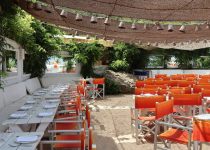Which Outdoor Deck Designs Work in Hot Climates?
When considering outdoor deck designs for hot climates, you'll want to focus on materials and features that enhance comfort and reduce heat. Choosing the right materials can make a significant difference in how your deck feels underfoot. Plus, incorporating elements like shade structures and water features can transform your space into a cool retreat. Curious about how to blend functionality with style? Let's explore the essential components that will make your outdoor deck enjoyable year-round.
Table of Contents
Key Takeaways
- Use heat-resistant materials like composite decking or hardwoods to reduce heat absorption and improve comfort underfoot.
- Incorporate shade structures such as pergolas or awnings to protect the deck from direct sunlight.
- Design water features like fountains or misters to create a cooling effect on hot days.
- Choose a variety of low-maintenance plants, such as succulents and Lantana, to enhance aesthetics and reduce care effort.
- Ensure proper ventilation and airflow to maintain a comfortable outdoor environment during peak sun hours.
Choosing the Right Materials for Heat Resistance
When you're designing an outdoor deck for a hot climate, choosing the right materials is crucial to ensure comfort and durability.
Opt for composite decking, as it resists fading and doesn't absorb heat like traditional wood. You'll find it's more comfortable to walk on during scorching days.
If you prefer natural materials, consider heat-resistant hardwoods like teak or mahogany, which offer durability and a beautiful finish. Avoid lighter-colored materials, as they can become too hot underfoot.
Additionally, think about using tiles or stone pavers, as they stay cooler and enhance your deck's aesthetic.
Remember to select materials that withstand high temperatures and are easy to maintain, ensuring your outdoor space remains inviting and functional all summer long.
Designing for Shade and Ventilation
When designing your deck for hot climates, creating shade is crucial for comfort and enjoyment.
You can incorporate structures like pergolas or awnings, along with natural ventilation techniques, to keep the area cool.
These elements not only enhance your outdoor space but also promote airflow, making those sunny days more bearable.
Shade Structures Importance
While outdoor living spaces can be a sanctuary in hot climates, effective shade structures are essential for keeping them comfortable and enjoyable.
You'll want to consider options like pergolas, canopies, or shade sails to block harsh sunlight. These structures not only provide relief from direct rays but also create a cozy atmosphere for relaxation.
Incorporating elements like climbing plants or outdoor curtains can enhance shade while adding beauty. When planning your space, think about positioning to maximize shade during peak sun hours.
Remember, choosing the right materials is crucial; lightweight fabrics or treated wood can withstand heat while maintaining aesthetic appeal.
Prioritizing shade structures will help you create an inviting outdoor environment you can enjoy year-round.
Natural Ventilation Techniques
Effective shade structures not only block the sun but also play a key role in promoting natural ventilation in your outdoor spaces.
To enhance airflow, consider positioning your deck to take advantage of prevailing winds. Use tall plants or decorative screens to create windbreaks, directing breezes through your seating areas.
Incorporate pergolas or awnings that allow for cross-ventilation while providing shade. Additionally, using lighter colors for your deck materials can reflect heat, keeping the area cooler.
Strategically placed ceiling fans can also boost airflow and create a more comfortable environment.
Incorporating Water Features for Cooling
To create a refreshing oasis in your outdoor deck, consider incorporating water features that not only enhance aesthetics but also provide a cooling effect. A small fountain or pond can add a soothing sound, helping you relax while lowering the surrounding temperature.
If space allows, think about a splash pool or a water wall; these features can significantly improve your comfort on hot days. You might also try adding misters or a simple water spray system, which can create a fine mist that cools the air.
Surround these features with lush plants to amplify the cooling effect and enhance the natural vibe. By integrating water elements into your design, you'll enjoy a more comfortable and inviting outdoor space all summer long.
Utilizing Light Colors to Reflect Sunlight
Creating a comfortable outdoor deck in hot climates goes beyond just adding water features. One effective strategy is using light colors for your deck materials and decor.
Light shades, like whites, creams, and pastels, reflect sunlight instead of absorbing it, keeping the surface cooler underfoot. This choice not only enhances your comfort but also creates a bright, inviting atmosphere that can make your deck feel more open and airy.
Consider light-colored wood, composite materials, or outdoor rugs that align with this theme. Additionally, you can incorporate light-colored cushions and umbrellas to further reduce heat absorption.
Selecting Heat-Resistant Furniture
When you're choosing furniture for your hot climate deck, consider materials that can withstand intense heat without fading or degrading.
The color of your furniture also plays a role, as lighter shades can help keep things cooler.
Finally, prioritize comfort and functionality to ensure your outdoor space remains inviting even on the hottest days.
Material Durability Considerations
Choosing the right materials for heat-resistant furniture is crucial in hot climates, as exposure to intense sunlight can quickly damage less durable options.
Opt for materials like aluminum, teak, or synthetic wicker, which withstand high temperatures and resist fading. Aluminum is lightweight, rust-resistant, and easy to maintain, making it an excellent choice for outdoor furniture.
Teak, while more expensive, offers natural oils that protect it from moisture and UV rays. Synthetic wicker mimics the look of natural wicker but is far more durable and weather-resistant.
Avoid plastic or untreated wood, as they can warp, crack, or fade over time. Investing in durable materials ensures your outdoor space remains inviting and functional, even under the harshest sun.
Color Temperature Effects
Although you mightn't think about it at first, the color of your outdoor furniture plays a significant role in its heat resistance. Darker colors absorb more heat, making them uncomfortable to sit on during those sweltering days.
If you want to keep your space cool, opt for lighter shades like whites, creams, or pastels. These colors reflect sunlight, helping maintain a more comfortable temperature.
Additionally, consider materials with heat-resistant coatings, as they can enhance the performance of your chosen color. If you already own darker furniture, adding cushions or throws in lighter shades can help mitigate heat absorption.
Ultimately, choosing the right color not only affects aesthetics but also enhances your outdoor experience in a hot climate.
Comfort and Functionality
To create a comfortable outdoor space in hot climates, selecting heat-resistant furniture is essential. Look for materials like aluminum, teak, or synthetic wicker that can withstand high temperatures without warping or fading.
Avoid dark-colored options, as they absorb heat and can become unbearable to sit on. Instead, choose lighter shades or reflective surfaces that stay cooler.
Consider adding cushions made from UV-resistant fabrics to enhance comfort while ensuring they're quick-drying.
Don't forget about shade—an umbrella or pergola can make a big difference.
Planning for Proper Drainage and Moisture Control
When you design an outdoor deck in a hot climate, planning for proper drainage and moisture control is essential to maintain its longevity and safety.
Start by choosing materials that resist moisture damage, like composite decking or treated wood. Ensure your deck has a slight slope away from your home to direct water runoff.
Incorporate drainage systems, like gutters or downspouts, to manage heavy rain. You can also use gravel or permeable pavers to facilitate water absorption.
Regular maintenance, such as cleaning debris from drainage areas, helps prevent clogging.
Lastly, consider installing a moisture barrier beneath the deck to protect the underlying structure.
Enhancing the Space With Heat-Tolerant Plants
Enhancing your outdoor deck with heat-tolerant plants not only adds beauty but also creates a more inviting atmosphere.
These plants thrive in warm climates, ensuring your deck remains vibrant and lively. Here are some fantastic options to consider:
- Succulents – Their unique shapes and colors bring a modern touch to your space.
- Lantana – This colorful flowering plant attracts butterflies, adding life to your deck.
- Agave – Its striking form and low maintenance make it a perfect choice for minimalists.
- Bougainvillea – Drape this vibrant, climbing plant for a stunning visual impact.
Frequently Asked Questions
How Can I Maintain My Deck During Extreme Heat?
To maintain your deck during extreme heat, regularly clean it, apply protective sealants, and ensure proper ventilation. Keeping it shaded with umbrellas or canopies can also help prevent damage and extend its lifespan.
What Are the Best Times to Use My Deck in Summer?
You'll want to enjoy your deck early in the morning or later in the evening when temperatures cool down. Midday heat can be intense, so plan your gatherings around those more comfortable hours instead.
Can I Install a Fire Pit in Hot Climates?
You can definitely install a fire pit in hot climates, but consider using heat-resistant materials and positioning it away from flammable structures. Enjoy the ambiance while ensuring safety and comfort during those warm evenings.
How Do I Protect My Deck From UV Damage?
To protect your deck from UV damage, apply a high-quality UV-resistant sealant. Regularly clean it to remove debris, and consider adding shade structures like umbrellas or pergolas to minimize direct sun exposure.
What Outdoor Lighting Works Best for Hot Weather?
For hot weather, consider LED outdoor lighting. They're energy-efficient, emit less heat, and resist fading. Using solar-powered fixtures can also be a great option, as they harness sunlight and reduce energy costs while illuminating your space beautifully.



